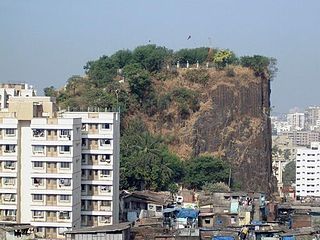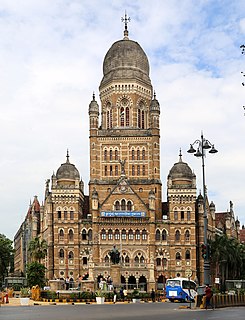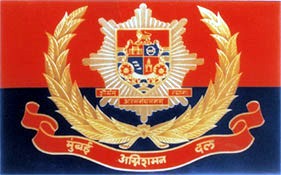
Mumbai is the capital city of the Indian state of Maharashtra and the de facto financial centre of India. According to the United Nations, as of 2018, Mumbai is the second-most populous city in India after Delhi and the eighth-most populous city in the world with a population of roughly 2 crore. As per the Indian government population census of 2011, Mumbai was the most populous city in India with an estimated city proper population of 1.25 crore (12.5 million) living under the Brihanmumbai Municipal Corporation. Mumbai is the centre of the Mumbai Metropolitan Region, the sixth most populous metropolitan area in the world with a population of over 2.3 crore. Mumbai lies on the Konkan coast on the west coast of India and has a deep natural harbour. In 2008, Mumbai was named an alpha world city. It has the highest number of millionaires and billionaires among all cities in India.

The Mumbai Suburban Railway consists of exclusive inner suburban railway lines augmented by commuter rail on main lines serving outlying suburbs to serve the Mumbai Metropolitan Region. Spread over 390 kilometres (240 mi), the suburban railway operates 2,342 train services and carries more than 7.5 million commuters daily.

Kurla is a neighbourhood of East Mumbai, India. It is the headquarters of the Kurla taluka of Mumbai Suburban district. The neighbourhood is named after the eponymous East Indian village that it grew out of. It falls under Zone 5, Ward 'L' of the Bombay Municipal Corporation. Its railway station, spelt as Coorla until 1890, is one of the busiest on the Mumbai suburban railway on the central and harbour railway lines of Mumbai as is the Lokmanya Tilak Terminus (LTT) for out-station passenger/express trains.

Mumbai Central is a major railway station on the Western line, situated in Mumbai, Maharashtra in an area known by the same name. It serves as a major stop for both Local and Inter-City/Express trains with separate platforms for them. It is also a terminal for several long-distance trains including the Mumbai Rajdhani Express. It is one of the five major Terminal stations in Mumbai while others being Mumbai CST, Mumbai LTT, Mumbai BDTS and Mumbai Dadar. Trains depart from the station connecting various destinations mostly across states in the northern, western and north-western parts of India. The station was renamed from Bombay Central to Mumbai Central in 1997, following the change of Bombay to Mumbai. In 2018, a resolution was passed to change the station code to MMCT, with implementation ongoing.

Navi Mumbai, is a planned city situated on the west coast of the Indian subcontinent, located in the Konkan division of Maharashtra state, on the mainland of India. Navi Mumbai is part of the Mumbai Metropolitan Region (MMR). The city is divided into two, North Navi Mumbai and South Navi Mumbai, for the individual development of Panvel Mega City, which includes the area from Kharghar to Uran, including the Taloja node. The Agri and Koli Communities mainly reside in Navi Mumbai. Navi Mumbai was the host city for the inaugural final of the IPL (2008) at D.Y Patil Stadium. Thane Belapur Marg and Palm Beach Marg are major business attraction and upmarket residential areas respectively. Navi Mumbai has a population of 1,119,477 as per the 2011 provisional census. It has an average city elevation of 14 meters, excluding forest area.
Dombivli is a city located near Mumbai in the Thane district of Maharashtra state, India. It is part of Mumbai Metropolitan Region (MMR).list. Current Municipal Commissioner 2022:- Dr Bhausaheb Dangde

Gilbert Hill is a 200 ft (61 m) monolith column of black basalt rock at Andheri, in Mumbai, India. The rock has a sheer vertical face and was formed when molten lava was squeezed out of the Earth's clefts during the Mesozoic Era about 66 million years ago. During that era, molten lava had spread around most of the Indian states of Maharashtra, Gujarat and Madhya Pradesh, covering an area of 50,000 square kilometres (19,000 sq mi). The volcanic eruptions were also responsible for the destruction of plant and animal life during that era. According to experts, this rare geological phenomenon was the remnant of a ridge and had clusters of vertical columns in nearby Jogeshwari which were quarried off two decades ago. These vertical columns are similar to the Devils Tower National Monument in Wyoming, and the Devils Postpile National Monument in eastern California, USA. Gilbert Hill was declared a National Park in 1952 by the Central Government under the Forest Act. In 2007, after years of lobbying by geologists, the hill was declared a Grade II heritage structure by the Municipal Corporation of Greater Mumbai (MCGM), and all quarrying and other activities around the monument were prohibited. Over the period of time, Gilbert Hill has faced severe erosion problems too.
The Harbour line is a branch line of the Mumbai Suburban Railway operated by Central Railway. It was named so because it catered to the eastern neighbourhoods along the city's natural harbour. Its termini are Chhatrapati Shivaji Maharaj Terminus (CSMT), Goregaon and Panvel on the CSMT-Goregaon, CSMT-Panvel and Panvel-Goregaon routes.
Mumbai Railway Vikas Corporation (MRVC) is under the ownership of Indian Railways, Ministry of Railways, Government of India. It was incorporated under Companies Act, 1956 on 12 July 1999 with an equity capital of Rs. 25 crore shared in the ratio of 51:49 between Ministry of Railways and Government of Maharashtra. MRVC is responsible to execute the projects under Mumbai Urban Transport Project (MUTP) as sanctioned by Ministry of Railways for enhancing suburban rail transportation capacity thereby reducing the over crowding and meeting future traffic requirements. The corporation will also be involved in the planning and development of Mumbai Suburban Rail system. The main objectives of MUTP are:

The Municipal Corporation Building, Mumbai, located in South Mumbai, Maharashtra, India is a Grade IIA heritage building opposite to the Chhatrapati Shivaji Terminus at the junction of Dadabhai Naoroji Road and Mahapalika Marg. It is also known as the BrihanMumbai Municipal Corporation Building, or BMC building for short.

Chinchpokli is a neighbourhood in South Mumbai. It is also the name of a railway station on the Central line of the Mumbai suburban railway. Historical British era spellings include Chinchpugli and Chinchpooghly. The neighbourhood is named after the Marathi words for tamarind (chinch) and betel nut (pofali).

Lokmanya Tilak Terminus is a railhead and a major railway terminus in the Kurla suburb of Mumbai, India. LTT is managed by the Central Railway. The Kurla and Tilak Nagar suburban railway stations are located nearby. It is one of the five railway terminals within Mumbai, the others being Chhatrapati Shivaji Terminus, Dadar on the Central line, and Mumbai Central and Bandra Terminus on the Western line.

The Mumbai Fire Brigade is the fire brigade serving the city of Mumbai, India. It is responsible for the provision of fire protection as well as responding to building collapses, drownings, gas leakage, oil spillage, road and rail accidents, bird and animal rescues, fallen trees and taking appropriate action during natural disasters.
The Western line of the Mumbai Suburban Railway is a public transit system serving Mumbai Metropolitan Region, Maharashtra. It consists of 37 stations from Dahanu Road to Churchgate railway station. It is operated by Western Railways (WR). The entire line is at grade.

Dadar railway station is one of the major interchange railway stations of Mumbai Suburban Railway. It serves the Dadar area in Mumbai, India.

Andheri is a passenger rail station located at Andheri suburb of Mumbai. It serves the Western line and Harbour lines of the Mumbai Suburban Railway. It is also a stop for some express trains and August Kranti Rajdhani Express. The station also inter-connects the Line 1 of the Andheri metro station. Andheri station first came under prominence after the development of Salsette–Trombay Railway services in 1928 by the British Empire of India during the pre-independence period.

Mira Road is a passenger railway station located at Mira Road, a suburb in the Western Suburbs of Mumbai. It is situated between Borivali and Bhayandar stations on the Western line, of Mumbai Suburban Railway. The route of the station is located between the salt pan towards the western zone of the suburb leading towards Bhayandar. Platform 1 and 3 are for north bound trains towards Bhayander and Virar while platform 2 and 4 are for south bound trains towards Borivali, Andheri, Bandra, Dadar and Churchgate. Slow trains use platform 1 and 2 while 3 and 4 are used by Fast trains originating from Virar.

Panvel railway station is a railway station on the Harbour Line and Central line of the Mumbai Suburban Railway network.
Maharashtra Rail Infrastructure Development Corporation is a Public Sector Undertaking (PSU) of Government of Maharashtra(GOM) and Ministry of Railways (MOR). The authorized share capital of MRIDC is Rs 100 Cr. with contribution of Rs. 50 Cr by Govt. of Maharashtra and Rs. 50 Cr. by Ministry of Railways. It is headquartered at Nariman Point, Mumbai and have offices across Maharashtra in Nagpur, Pune, and Nashik. The corporation is involved in implementation of various Railway projects such as construction of ROB in lieu of level crossings, construction of new Railway Line and expansion of existing Railway Lines in the territory of Maharashtra. It started functioning from July 2018.














